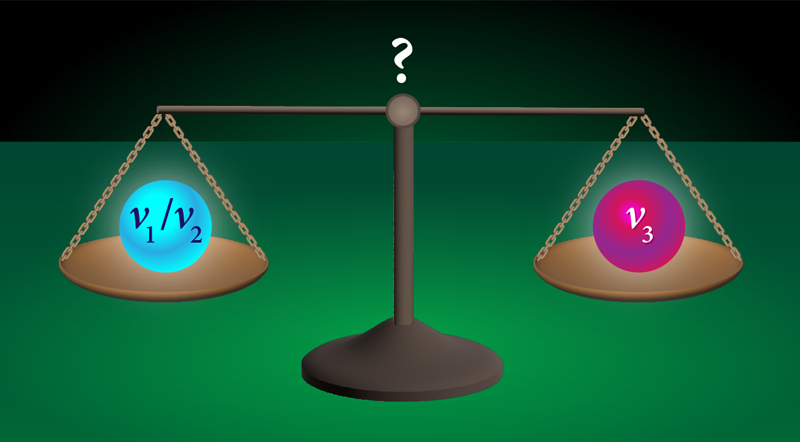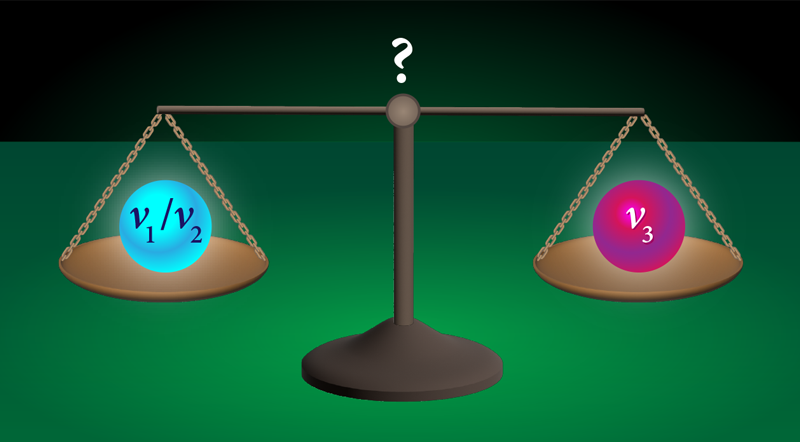Atmospheric Neutrinos Revisited
Neutrinos are fickle. Produced with a certain leptonic flavor (electron, muon, or tau), neutrinos can change their flavor as they travel through space. In 1998, researchers discovered this beyond-standard-model neutrino-oscillation phenomenon using neutrinos from natural sources—Earth’s atmosphere and the Sun. Increasingly accurate experiments also involved artificial neutrino sources such as accelerators and nuclear reactors. These experiments have significantly advanced our understanding of neutrino oscillations but haven’t yet solved two important related questions regarding the ordering of neutrino masses and possible violations by neutrinos of a fundamental symmetry known as charge-parity (CP) symmetry. New work by Carlos Alberto Argüelles-Delgado of Harvard University and colleagues shows that atmospheric neutrino experiments, once pivotal in the discovery of neutrino oscillation, can still play a key role in answering those questions [1]. Their analysis indicates that by 2030 a combined analysis of four leading atmospheric-neutrino experiments could settle the neutrino-mass-ordering problem and also set tighter constraints on CP violation and on other neutrino oscillation parameters.
Atmospheric neutrinos are produced when cosmic rays from outer space collide with Earth’s atmosphere, producing a cascade of particles, most of which rapidly decay to neutrinos and other products. Atmospheric neutrinos span a broad energy range and come from all directions, allowing measurements over many orders of magnitude in neutrino energy and over propagation “baselines” ranging from 15 km (the altitude at which neutrinos are produced in the atmosphere) to over 12,000 km (Earth’s diameter). These features make atmospheric neutrinos unique probes of neutrino oscillations.
Atmospheric neutrinos were indeed key to the discovery of neutrino oscillations through the observation of an “atmospheric-neutrino anomaly”: the Super-Kamiokande detector in Japan observed fewer muon neutrinos coming up through Earth than coming down from above (see Focus: Nobel Prize—Neutrinos Oscillate). Neutrino flavor oscillation is a quantum-mechanical phenomenon with a probability dependent on a neutrino’s energy and on the distance the particle travels. When muon-flavored atmospheric neutrinos propagate thousands of miles through Earth, half of them oscillate into tau neutrinos. On the other hand, muon neutrinos traveling a much shorter distance through the atmosphere mostly remain in their muon flavor.
Oscillations occur because a neutrino of each flavor is a linear superposition of three eigenstates with distinct masses: 𝜈1, 𝜈2, and 𝜈3. The absolute values of the mass differences and the superposition coefficients, or “mixing angles,” are well constrained by various measurements using neutrinos from accelerators, reactors, and the Sun. However, the ordering of the masses—whether 𝜈3 is heavier or lighter than 𝜈2 and 𝜈1—remains an open question (Fig. 1). Another unknown parameter in neutrino oscillation is the so-called CP-violation phase, which describes differences in the oscillating behavior of neutrinos and of their antiparticles (antineutrinos). Characterizing neutrino CP violation may hold the key to solving one of physics’ greatest puzzles—the dominance of matter over antimatter in the Universe.
To tackle these questions, researchers are building accelerator-based neutrino experiments with hundreds-of-kilometers-long baselines, such as Super-Kamiokande’s successor in Japan, Hyper-Kamiokande, and the Deep Underground Neutrino Experiment (DUNE) in the US. These sophisticated experiments provide high-purity, intense, and directional neutrino (or antineutrino) beams that can be monitored at a near detector and at a far detector, offering a controlled setup for oscillation measurements. Yet, atmospheric neutrinos continue to offer, for free, an enormous amount of neutrinos in a wider energy range. Through an analysis of 24 years of data, Super-Kamiokande recently showed that atmospheric-neutrino measurements are sensitive to mass ordering [2]. This sensitivity owes to the fact that the oscillation probability for neutrinos propagating through Earth is modified by so-called matter effects, which would lead to different behavior for different mass ordering.
To assess what further information can be gleaned from atmospheric-neutrinos experiments, Argüelles and colleagues investigate the sensitivity achievable through a combined analysis of data from Super-Kamiokande and from three near-future atmospheric-neutrino experiments—Hyper-Kamiokande, KM3Net-ORCA, and an upgrade to the South Pole neutrino observatory, IceCube. As mentioned, Hyper-Kamiokande is a long-baseline experiment, but its 258-kiloton water detector will also be sensitive to atmospheric neutrinos. KM3Net-ORCA will probe neutrino interactions in a volume of 7 megatons of water in the Mediterranean Sea, while the IceCube Upgrade will use a cubic kilometer of ice. All these experiments are based on spotting neutrinos through Cherenkov radiation—photons emitted by charged particles that are produced from neutrino collisions with atoms and that travel at a speed greater than the phase velocity of light in the medium.
Argüelles and his colleagues point out the synergies between these experiments, proposing a combined analysis of the experiments to constrain oscillation parameters and to reduce correlated systematic uncertainties. Each of the detectors will provide unique contributions to this global analysis. Due to their larger detector volume and photon-detection scheme, IceCube Upgrade and KM3Net-ORCA will be particularly sensitive to high-energy atmospheric neutrinos. The expected statistics of their detections should allow precise measurements of mixing angles and mass differences, as demonstrated by a recent result from the IceCube DeepCore, which reached a comparable precision to accelerator experiments [3]. On the other hand, Hyper-Kamiokande, thanks to its higher density of photon sensors, will be more sensitive to lower-energy neutrinos, which should enhance the sensitivity to CP violation. Argüelles and colleagues find that the CP-violation phase is the parameter that will benefit the most from the combined analysis. They also conclude that such analysis could yield a determination of neutrino mass ordering with 5σ statistical confidence by 2030 (such conclusion assumes that KM3Net-ORCA and IceCube Upgrade start data taking in 2025 and in 2027, respectively).
The results of atmospheric-neutrino analyses such as the one proposed by Argüelles and colleagues will provide valuable input to next-generation accelerator-based experiments, complementing them in terms of energy range and oscillation baselines. It’s worth noting that other upcoming neutrino experiments—not considered in this work—will have atmospheric-neutrino components. Such experiments include DUNE, whose far detectors should start taking data in 2029. Thanks to a liquid-argon time-projection-chamber technique, DUNE will be better suited than Hyper-Kamiokande to probing low-energy atmospheric-neutrino interactions, which will be a boon to studies of CP violation [4]. Together, these developments bode well for expanding our understanding of neutrino oscillations beyond the current paradigm.
References
- C. A. Argüelles et al., “Measuring oscillations with a million atmospheric neutrinos,” Phys. Rev. X 13, 041055 (2023).
- T. Wester et al. (Super-Kamiokande Collaboration), “Atmospheric neutrino oscillation analysis with neutron tagging and an expanded fiducial volume in Super-Kamiokande I-V,” arXiv:arxiv: 2311.05105.
- R. Abbasi et al., “Measurement of atmospheric neutrino mixing with improved IceCube DeepCore calibration and data processing,” Phys. Rev. D 108, 012014 (2023).
- K. J. Kelly et al., “Sub-GeV atmospheric neutrinos and CP violation in DUNE,” Phys. Rev. Lett. 123, 081801 (2019).





